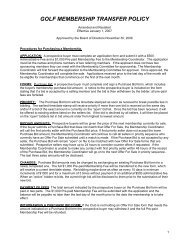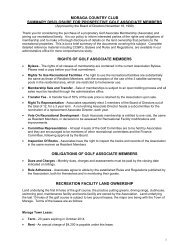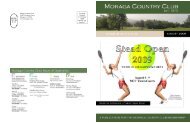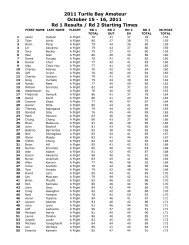Handicapping: The Basics - Golf Fusion
Handicapping: The Basics - Golf Fusion
Handicapping: The Basics - Golf Fusion
You also want an ePaper? Increase the reach of your titles
YUMPU automatically turns print PDFs into web optimized ePapers that Google loves.
<strong>Handicapping</strong>: <strong>The</strong> <strong>Basics</strong><br />
What is the Purpose of the USGA Handicap System?<br />
<strong>The</strong> purpose of the USGA Handicap System is to make the game of golf more enjoyable<br />
by enabling golfers of differing abilities to compete on an equitable basis.<br />
What is a Handicap Index?<br />
A USGA Handicap Index indicates a golfer’s skill and comes in the form of a number<br />
taken to one decimal place. A USGA Handicap Index compares a player’s scoring ability<br />
to the scoring ability of an expert amateur on a course of standard difficulty.<br />
How is a USGA Handicap Index Established?<br />
To establish a Handicap Index, a player posts his/her scores along with the appropriate<br />
USGA Ratings to compile a scoring record. A Handicap Index is computed from no more<br />
than 20 scores. <strong>The</strong> Handicap Index is intended to reflect the player’s potential and is<br />
thus based on the best scores posted for a given number of rounds. Ideally, a handicap<br />
index is computed based on the best 10 of the last 20 18-hole rounds. However, an initial<br />
handicap index can be established based on a minimal of 5 18-hole rounds.<br />
To establish a handicap you must:<br />
• Play your best round possible for each round of golf played, and<br />
• Post every acceptable round played (according to USGA rules)<br />
It is not acceptable to only post select scores toward your handicap. To establish a<br />
valid handicap, all scores must be posted. <strong>The</strong>re are even special rules for how to<br />
adjust your score if you do not complete all holes. If you pick up on a hole, you<br />
are supposed to record the score you “most likely” would have made. That score,<br />
however, must not exceed your “Equitable Stroke Control” limit (see below).<br />
When a hole isn’t played, you should record a par plus any handicap strokes you<br />
would have received. All scores where you have played at least 13 holes should<br />
be posted.<br />
How is a Handicap Index Generally Used?<br />
A USGA Handicap Index travels from course to course, as well as from one set of tees to<br />
other sets of tees on the same course. A players handicap index determines the number of<br />
strokes a player receives depending on the difficulty of the course he/she plays. A<br />
handicap index is converted to a Course Handicap for competition on a particular course.<br />
Each Course has a Course handicap Table which converts the USGA Handicap Index to a<br />
Course Handicap based on a conversion formula. This conversion process is what makes<br />
handicaps “portable” and what insures equity between players. Once all handicap<br />
indexes are converted to a course handicaps for the particular course, the number of<br />
strokes a player gets depends on the format or the type of competition (ie. Individual<br />
Stroke play, Match Play, Best Ball, etc..) <strong>The</strong>re are different handicap allowance rules<br />
depending on the type of game being played.
Once the number of strokes a player gets is determined, the next question is where do you<br />
get the strokes. Each hole has a handicap allocation number. <strong>The</strong> hole with handicap #1 is<br />
the hardest hole or the hole where you are most likely to need a stroke. <strong>The</strong> hole with<br />
handicap #18 is the hole where you are least likely to need a stroke. In a case of net<br />
match play, if player number 1 has a course handicap of 20 and player number 2 has a<br />
course handicap of 15, player number 1 will get 5 strokes. <strong>The</strong>se 5 strokes will be given<br />
to player number 1 as 1 stroke each for the holes with handicap numbers 1 thru 5.<br />
Assume, on the # 1 handicapped hole player number 1 scores a 6. Player number 1 will<br />
get to subtract the one stroke handicap for this hole and record a net score of 5. If player<br />
number 2 scores a 5 they will tie the hole.<br />
In net stroke play events the process is simpler. Each player would simply deduct his or<br />
her Course handicap from the final actual gross score when the round is finished.<br />
Definition of Terms Used in Establishing Handicaps<br />
USGA Course Rating: USGA’s mark that indicates the evaluation of the playing<br />
difficulty of a course for scratch golfers under normal conditions based on yardage and<br />
other obstacles that affect their scoring ability. <strong>The</strong> more difficult the course for the<br />
scratch golfer, the higher the Course rating.<br />
USGA Slope Rating: An evaluation of how much more difficult the course is for those<br />
who aren’t scratch golfers. Each course is rated from each set of tees for both the scratch<br />
golfer and the bogey golfer. <strong>The</strong> Course rating reflects the difficulty of the course for the<br />
scratch golfer. <strong>The</strong> course rating and slope rating together reflect the difficulty of the<br />
course for non-scratch golfers. <strong>The</strong> greater the difference between the scores of the<br />
scratch and bogey golfer on a certain course, the higher the USGA slope rating. A golf<br />
course of ‘standard” playing difficulty has a USGA slope rating of 113. <strong>The</strong> lowest slope<br />
rating is 55 and the highest slope rating is 155. <strong>The</strong> higher the slope rating, the more<br />
difficult the average golfer will find the course.<br />
Slope is what makes your handicap portable. Converting your USGA Handicap Index to<br />
a Course rating is based on the course slope rating. You get more strokes on a course with<br />
a higher slope; on a course with a lower slope you receive fewer strokes.<br />
Scratch <strong>Golf</strong>er: A scratch golfer is an amateur player who plays to the standard of the<br />
field of stroke-play qualifiers competing at the Mens/Womens U.S. Amateur<br />
Championship site. A male scratch golfer can hit tee shots an average of 250 yards and<br />
can reach a 470-yard hole in two shots. A female scratch golfer can hit tee shots an<br />
average of 210 yards and can reach a 400-yard hole in two shots.<br />
Bogey <strong>Golf</strong>er: A male bogey golfer has a USGA Handicap Index of 17.5 to 22.4. He can<br />
hit tee shots an average of 200 yards and can reach a 370-yard hole in two shots. A<br />
female bogey golfer has a USGA Handicap Index of 21.5 to 26.4. She can hit tee shots<br />
and average of 150 yards and can reach a 280-yard hole in two shots.
What is Equitable Stroke Control?<br />
Equitable Stroke Control (ESC) keeps an exceptionally bad hole from changing your<br />
Handicap Index too much. ESC is used to adjust scores back into the normal range. ESC<br />
sets a maximum number that a player can post on any hole depending on the player’s<br />
Course handicap. For Handicap purposes, you are required to adjust your hole scores<br />
when they are higher than the maximum number you can post. <strong>The</strong>re is no limit to the<br />
number of holes on which you can adjust your score.<br />
Equitable Stroke Control Limits:<br />
If your 18 Hole Course Handicap Is <strong>The</strong> Maximum Score on Any Hole Is:<br />
9 or less Double Bogey<br />
10 through 19 7<br />
20 through 29 8<br />
30 through 39 9<br />
40 and Above 10
















